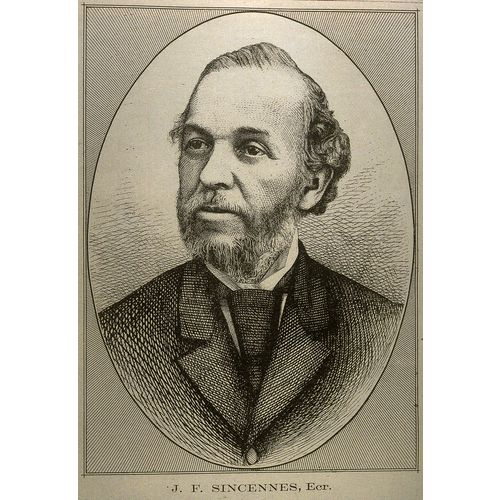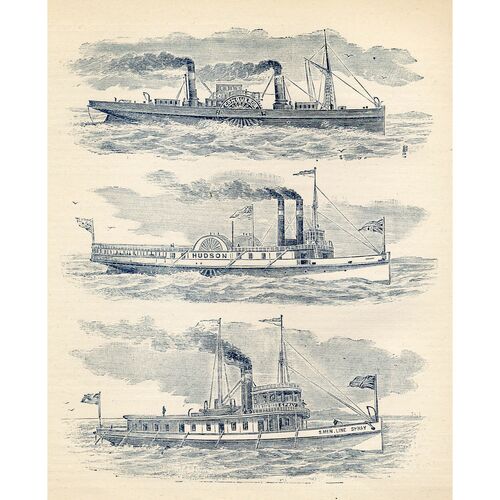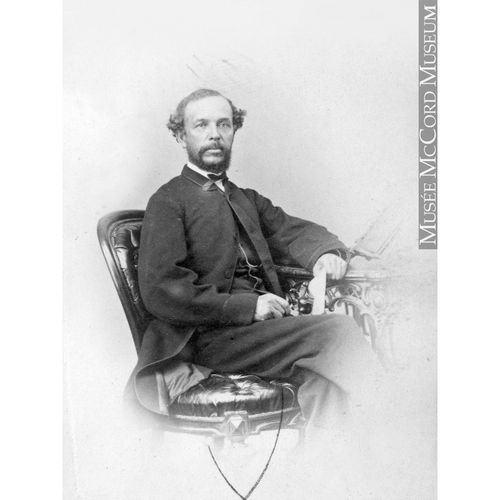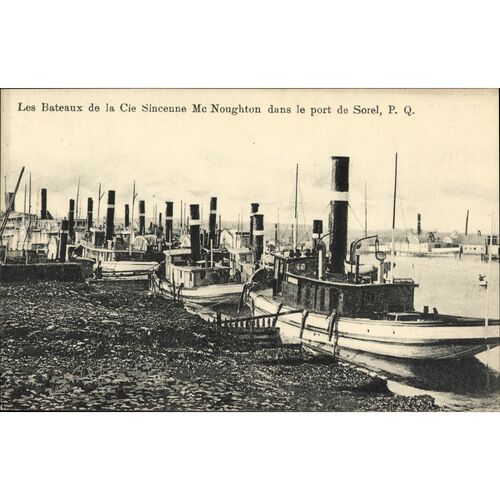SINCENNES (Saincennes), JACQUES-FÉLIX, shipowner, businessman, and politician; b. in Deschambault, Hampshire County (Portneuf), L.C., 7 Jan. 1818, son of Jacques Saincennes, a farmer and pilot, and Marie-Josephte Marcotte; d. at Montreal, Que., 20 Feb. 1876.
The Saint-Seine family were Acadians, who had originally come from the village of Bourguignon, near the source of the Seine in France. At the time of the expulsion of the Acadians, they settled on the north shore of the St Lawrence, and the name became first Saincennes and then Sincennes, which is the form Jacques-Félix used. At the age of 13, after six years at school, he was apprenticed to his father as a pilot and for two years plied the St Lawrence between Quebec and Montreal. He then returned to school to finish his education and was thereafter employed as a clerk in a commercial house, before he obtained the post of purser in 1839 on a Montreal-Laprairie steamer.
Sincennes soon realized that one of the great needs of the region was a steamship service on the Richelieu River to carry produce from Chambly to William-Henry (Sorel) and on to Montreal: a 90-mile route in all. In 1845 he held a series of meetings of the Richelieu habitants, at such centres as Saint-Charles-sur-Richelieu, at which subscriptions were raised to the value of £3,715; this amount was used to build the side-wheeler Richelieu (the first ship built at the Sorel shipyards) and the barge Sincennes. The new company was called “La Société de Navigation de la Rivière Richelieu.” Sincennes became the captain, in which capacity he not only transported produce, but soon performed the apparently impossible task of moving square timber from William-Henry to Chambly.
Almost immediately a rival line was formed and the first of many amalgamations took place, resulting in the Richelieu Company (La Compagnie du Richelieu), which was incorporated by statute in 1848. The founders and stockholders were all French and French was the language in which the entire business of the company was conducted until 1875. By 1848 operations had so expanded that Sincennes gave up the captaincy to conduct the shore business; he was secretary-treasurer of the company for many years, president for a decade, and a director until his death. His policy was one of continued expansion and, when competition broke out, amalgamation with his rivals. In 1856 the company launched the Victoria and the Napoléon and entered the hotly contested Montreal-Quebec run in rivalry with the Molson, Torrance, and Tate interests [see Torrance]. At the same time it took over the fleet of the Montreal and Three Rivers Navigation Company. In 1857 the Richelieu Company was capitalized by statute at £75,000 and in that year it paid a 32 per cent dividend. The next year the Torrance interests were incorporated into the company and David Torrance became a director, thus ending the competition.
In 1860 the expanded organization made a profit-pooling agreement with the Toronto-Montreal Royal Mail Line to prevent competition. The St Lawrence North Shore Navigation Company was taken over in that same year and the Lake St Peter Navigation Company and the Terrebonne and L’Assomption Navigation Company in 1861. By this time “in many cases the season’s operations resulted in gross earnings greater than the total capital of the company,” which by 1861 was $161,733. In 1862 the charter of the Richelieu Company was extended to permit operations throughout the St Lawrence and the Great Lakes. The final amalgamation with which Sincennes was involved came in 1875, after a period of rivalry, when the Richelieu Company joined with the Canadian Navigation Company (formerly the Royal Mail Line) of Sir Hugh Allan* to found the Richelieu and Ontario Navigation Company (from 1913 Canada Steamship Lines), which operated a total of 18 ships on the Great Lakes and St Lawrence and had a paid up capital of $750,000. Sincennes remained a director of the new corporation.
While establishing the Richelieu Company, Sincennes was also involved with another important shipping operation. In 1849 he and William McNaughton, whose interests lay in Ottawa valley lumber and forwarding, formed a partnership, the Sincennes-McNaughton Line (today McAllister Towing Limited). With headquarters at Sorel and Montreal, this company specialized in towing and berthing ships, as well as towing timber rafts and lumber barges on the Ottawa, Richelieu, and St Lawrence rivers, as far east as Quebec. The tugs used were of the side-wheel type. Sincennes was the president in what must have been an amiable relationship, for he and McNaughton were also engaged in various other partnerships such as the Montreal and Ottawa Forwarding Company, formed in 1865.
Sincennes took part in many other commercial and financial enterprises: in 1873, with McNaughton and others, he founded the Royal Canadian Insurance Company of Montreal and at the end of its first year became president. By 1875 the company had 300 agencies in Canada and the United States. He was, in addition, vice-president of La Banque du Peuple and was involved with companies manufacturing cotton and india-rubber goods.
In 1853 he was appointed a magistrate of the Montreal district and in 1857 made a brief entry into politics, running as a Ministerialist (Conservative) for the County of Richelieu, in which he had his residence, at Sorel. On December 28–29 by 1,204 votes to 1,169 he defeated the sitting member, Jean-Baptiste Guévremont, who appealed unsuccessfully. Sincennes, however, did not run in the next election, in July 1861.
He married twice: first, Clotilde-Héloise Douaire Bondy, by whom he had a son and three daughters; the second time, in 1866, Delphine-Denise Perrault, widow of lawyer Victor-Henri Bourgeau. There were no children by the second marriage. A man of medium stature, and faultless dress, Sincennes was noted in Montreal for the regularity of his habits. When asked what he took as his motto he replied: Esse potius quam videri: to be rather than to seem. Although he lived in Sorel for much of his life, and was also a magistrate of this district, he spent his last years at Montreal, where his funeral service at Saint-Jacques-le-Majeur was conducted by Bishop Édouard-Charles Fabre*.
AJM, Registre d’état civil. AJQ, Registre d’état civil. PAC, MG 30, D62 (Audet papers), 28, pp.107–8; RG 68, 240, p.49; Liber 21, p.171. Canada, Province of, Legislative Assembly, Journals, 1858; Statutes, 1857, c.170; 1862, c.69. Canada, Statutes, 1873, c.99. Andrew Merrilees, “A history of the Sincennes-McNaughton Line” (typescript, property of McAllister Towing Ltd, Montreal). Montreal Gazette, 2 Jan. 1858, 12 July 1861, 15 Feb. 1862, 21 Feb. 1876. Le Nouveau Monde (Montréal), 21 févr. 1876. L’Opinion publique (Montréal), 25 avril 1875, 2 mars 1876. Pilot and Journal of Commerce (Montreal), 5 Jan. 1858. The Mercantile Agency reference book (and key) for the dominion of Canada . . . Jan., 1876 (Montreal, 1876), 319, 511. Atherton, Montreal, II 168, 531, 574, 577. Azarie Couillard-Després, Histoire de Sorel de ses origines à nos jours (Montréal, 1926), 281, 297–98, 308–12. James Croil, Steam navigation in Canada and its relation to the commerce of Canada and the United States (Toronto, 1898), 314–15. M. J. Patton, “Shipping and canals,” Canada and its provinces (Shortt and Doughty), X, 539, 541–42, 551. L. C. Tombs, National problems of Canada; the port of Montreal (McGill University Economic Studies, 6, Toronto, 1926), 43. Turcotte, Canada sous l’Union, II, 384. Wood, All afloat, 148–50. R. W. Shepherd, “The Richelieu and Ontario fleet,” Detroit Marine Historian, VIII (March–June 1955).
Cite This Article
Frederick H. Armstrong, “SINCENNES (Saincennes), JACQUES-FÉLIX,” in Dictionary of Canadian Biography, vol. 10, University of Toronto/Université Laval, 2003–, accessed December 30, 2025, https://www.biographi.ca/en/bio/sincennes_jacques_felix_10E.html.
The citation above shows the format for footnotes and endnotes according to the Chicago manual of style (16th edition). Information to be used in other citation formats:
| Permalink: | https://www.biographi.ca/en/bio/sincennes_jacques_felix_10E.html |
| Author of Article: | Frederick H. Armstrong |
| Title of Article: | SINCENNES (Saincennes), JACQUES-FÉLIX |
| Publication Name: | Dictionary of Canadian Biography, vol. 10 |
| Publisher: | University of Toronto/Université Laval |
| Year of publication: | 1972 |
| Year of revision: | 1972 |
| Access Date: | December 30, 2025 |


![J. F. Sincennes, Ecr. [image fixe] Original title: J. F. Sincennes, Ecr. [image fixe]](/bioimages/w600.4384.jpg)




